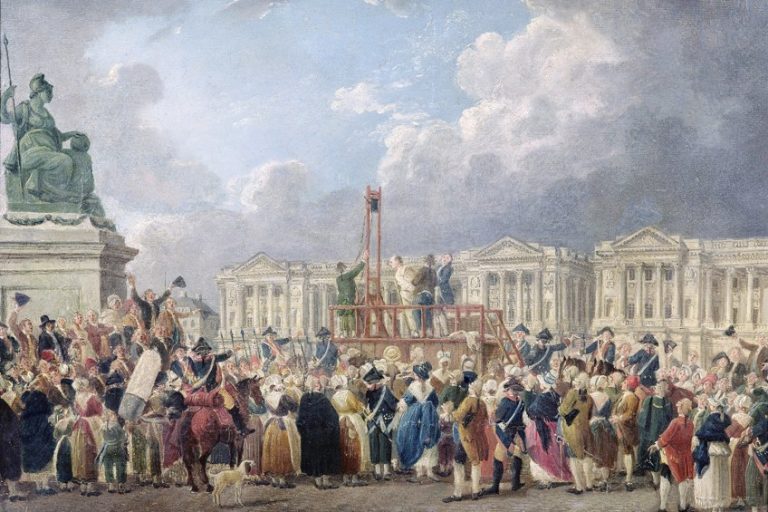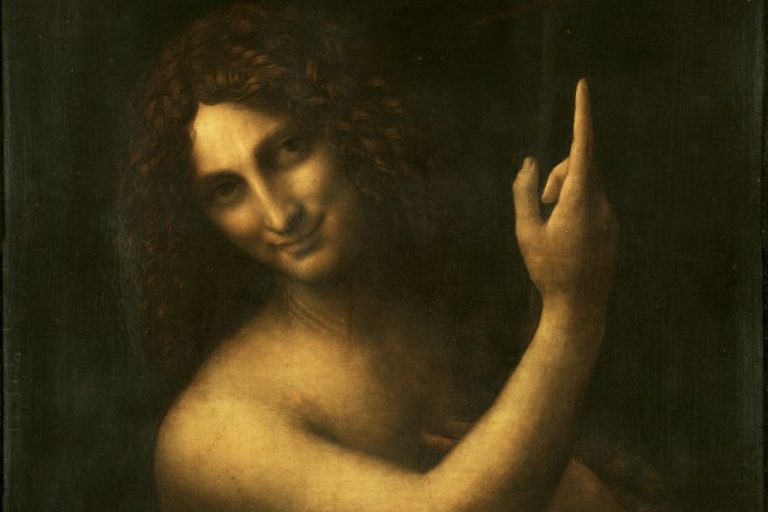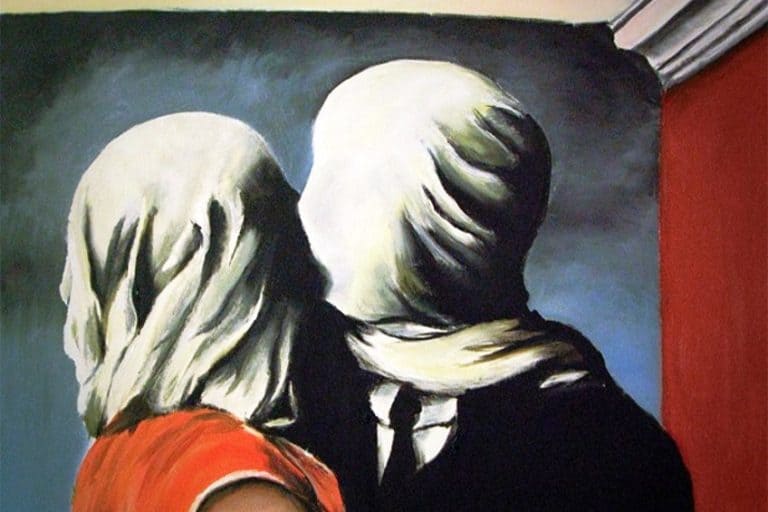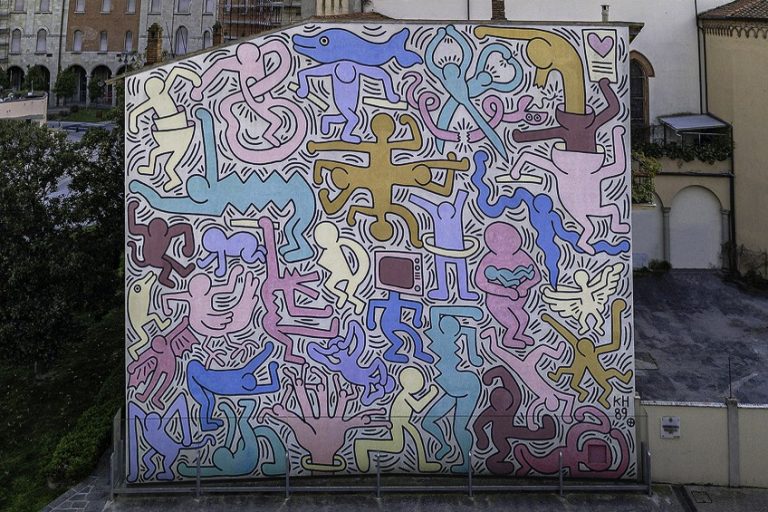“Catalan Landscape” by Joan Miró – The Colors of Catalonia
Catalan Landscape (The Hunter), created by Joan Miró between 1923 and 1924, stands as a seminal work within the Surrealist movement, encapsulating the artist’s innovative approach to abstraction and symbolism. This oil painting is a vivid, dreamlike portrayal of Miró’s Catalan roots, blending fantastical elements with a sense of whimsy and mystery. The canvas is populated with enigmatic figures, curious creatures, and abstract forms, all rendered in a vibrant, playful palette that reflects Miró’s distinctive style. Through Catalan Landscape (The Hunter), Miró invites viewers into a surreal and poetic world that challenges conventional perceptions of reality and exemplifies his masterful integration of imagination and cultural identity.
Key Takeaways
- Catalan Landscape by Joan Miró features symbolic imagery and abstract forms.
- The painting combines elements of reality and imagination, characteristic of Miró’s style.
- It is a significant work that showcases Miró’s artistic innovation and influence.
Historical Context of the Painting
| Artist | Joan Miró (1893 – 1983) |
| Date Created | 1923 – 1924 |
| Medium | Oil on canvas |
| Genre | Surrealism |
| Period/Movement | Surrealism |
| Dimensions (cm) | 64.8 x 100.3 |
| Series/Versions | None |
| Where Is It Housed? | The Museum of Modern Art, New York City, United States |
| What It Is Worth | Estimated at $40-50 million (value based on recent market trends) |
Joan Miró’s Catalan Landscape is a captivating work that showcases the artist’s distinct Surrealist style. Painted between 1923 and 1924, this piece offers a visual feast of symbolic imagery and abstract forms. At first glance, the painting might seem whimsical and chaotic, but it reveals much about Miró’s unique vision and approach to art. In the foreground, a hunter stands with his stick figure body and triangular head, while natural forms and curious shapes populate the canvas.

This blend of reality and imagination is a hallmark of Miró’s work, making Catalan Landscape both intriguing and thought-provoking. The presence of human and animal figures, combined with elements of the landscape, tell a story that spans both the literal and the fantastical. Joan Miró’s artwork is a testament to his innovative spirit and his ability to convey complex ideas through simple forms. Catalan Landscape remains a significant piece in his oeuvre, influencing future artistic directions and captivating audiences with its depth and creativity.
Joan Miró and Surrealism
Joan Miró was a pivotal figure in the Surrealist movement, which sought to unlock the power of the imagination by tapping into the unconscious mind. He began to explore Surrealism in the early 1920s, and by 1924, when Catalan Landscape was painted, his style had matured.
Miró’s work during this period is characterized by automaton, a technique aimed at facilitating the free flow of subconscious thought.
Catalan Landscape incorporates abstract shapes and symbols that transcend literal representation, embodying Surrealist aims to blur the lines between reality and dreams. This painting was part of a broader artistic push to challenge and expand the boundaries of conventional art forms, striving for a new visual language.
Influence of Catalonia on Miró’s Work
Catalonia had a profound influence on Miró’s art, providing a rich cultural and physical backdrop. Born in Barcelona, Miró spent much of his time in Mont-roig, a rural area that profoundly impacted his work. This landscape is a recurring element in his paintings, infusing his abstract forms with a sense of place.
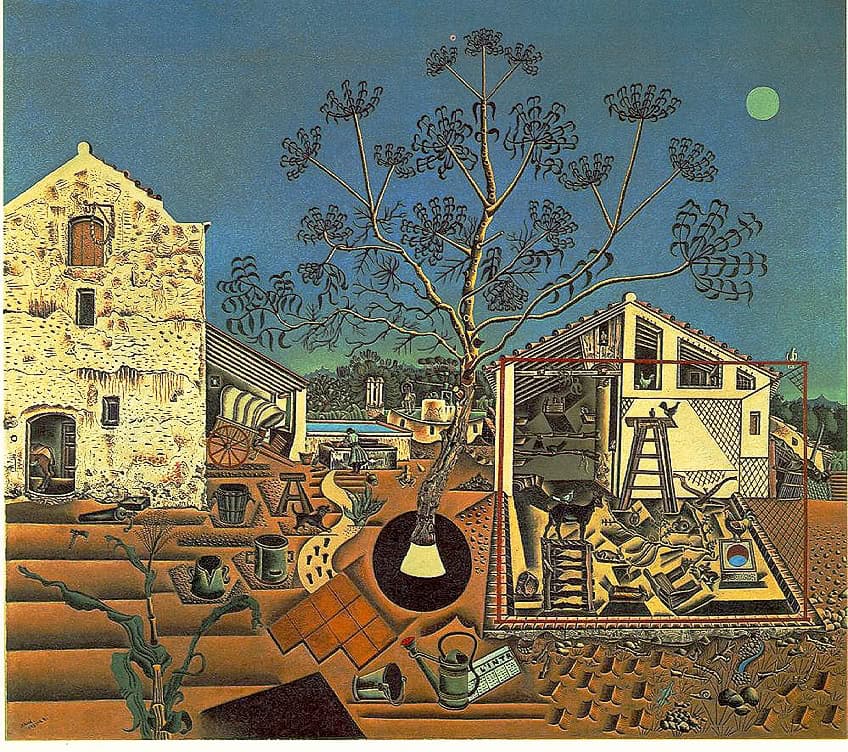
Catalan Landscape reflects this connection, with its abstract elements suggesting Catalan scenery and symbols. The piece includes a hunter, a frequent symbol in Catalan folklore, and natural forms inspired by the region’s geography. Miró’s ties to Catalonia provided a persistent source of inspiration, grounding his abstract compositions in a personal and cultural narrative.
Artistic Elements of Catalan Landscape
Catalan Landscape by Joan Miró showcases his unique style through its abstract forms, rich symbolism, vibrant colors, and innovative techniques. This piece highlights his transition to Surrealism while maintaining strong ties to his Catalan identity.
Color and Composition
Miró employs a vivid color palette to evoke emotions and establish a dreamlike atmosphere. The background is often a mix of blues and greens, representing the Catalan countryside. Bright reds, yellows, and oranges stand out, drawing attention to specific elements within the painting. The composition is dynamic, with various shapes and lines leading the eye across the canvas. Miró balances chaotic elements with orderly shapes, creating a sense of harmony and movement. Each section of the painting tells part of a larger story, contributing to the overall narrative.
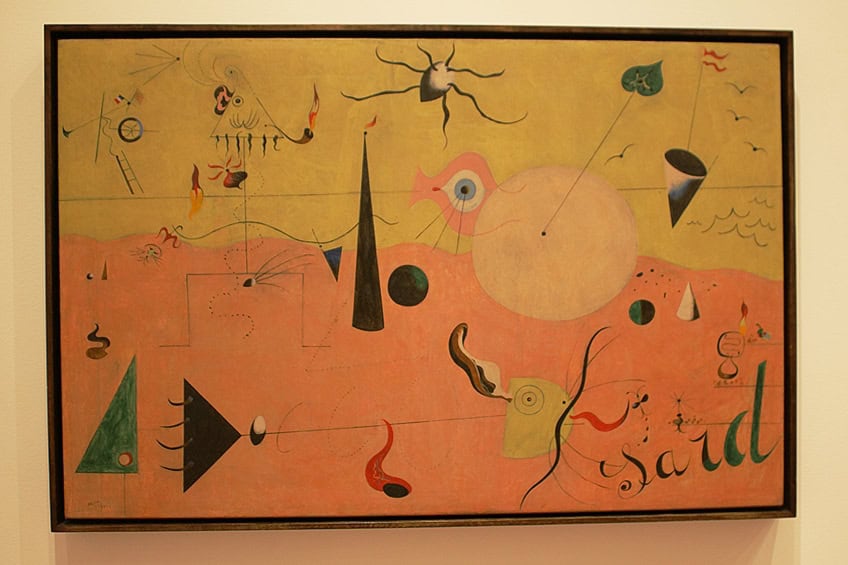
Abstract Forms and Symbolism
Abstract forms dominate the canvas, blending the real and imagined. Miró uses simplified shapes like circles, triangles, and lines to represent figures, animals, and natural elements. These abstract forms are not random; they are carefully crafted symbols with deeper meanings. For instance, a stick figure of a hunter with a triangular head and pipe embodies Miró’s Catalan heritage. Flags, stars, and constellations add layers of cultural and personal symbolism, reflecting dreams and subconscious thoughts.
These symbols provide a visual language that invites viewers to interpret the painting in multiple ways.
Techniques and Materials
Miró’s techniques in Catalan Landscape demonstrate his skill and innovation. He employs automatism, where he lets his subconscious guide the brushstrokes. This results in fluid, spontaneous forms that hover between reality and imagination.
The painting is done on canvas, using oil paints that allow for rich textures and vibrant colors. Miró experiments with line quality, from thin, delicate lines to bold, sweeping strokes. Each mark on the canvas is purposeful, contributing to the painting’s cohesive aesthetic.
This method bridges the gap between figuration and abstraction, making Catalan Landscape a cornerstone of his Surrealist period.
Interpretations and Significance
Joan Miró’s Catalan Landscape (The Hunter) is rich with symbolic meaning and showcases his innovative contributions to the Surrealist movement, blending elements from various influences with a distinct style.
Role of the Hunter
The hunter in the painting is a key figure, portrayed as a stick figure with a triangular head. This simple representation contrasts with the detailed background, highlighting the hunter’s importance. He stands on the left with a pipe, adding a human element.
This figure symbolizes survival and connection to nature, themes central to Catalan culture.
Surrealist elements and Dada influences appear through the hunter’s exaggerated features, demonstrating Miró’s integration of subconscious imagery. The hunter also serves as an anchor, grounding the viewer in the otherwise abstract landscape, allowing them to explore deeper symbolism.
Miró’s Artistic Innovation
Joan Miró’s artwork is noted for its innovative approach, blending dreamlike and real elements. In “Catalan Landscape, his use of automatism is evident, with spontaneous shapes and symbols creating a vivid portrayal of the subconscious. Miró incorporates elements from his environment into the Surrealist and Dada movements, influenced by André Breton and other contemporary artists.
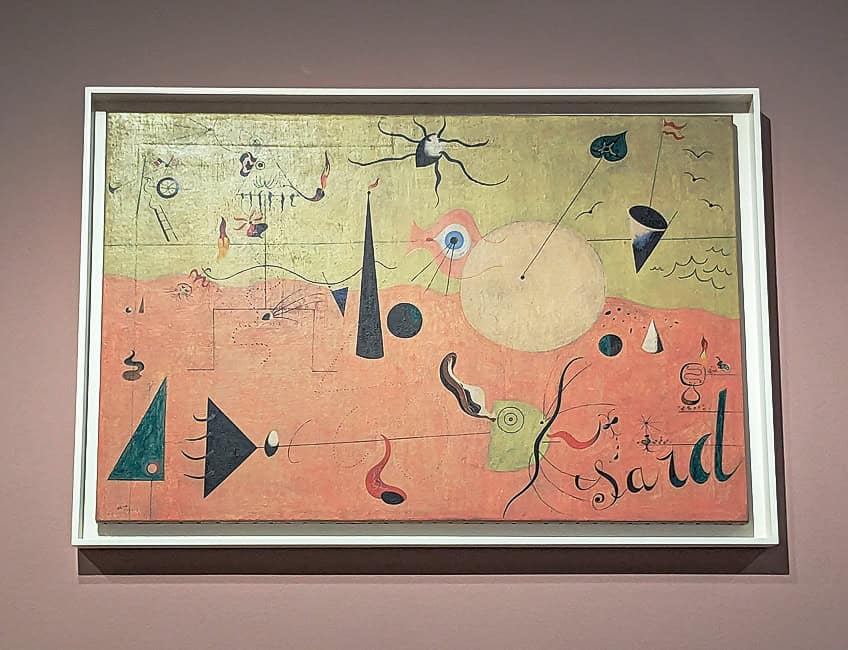
His use of bold colors and abstract forms challenges traditional art norms, pushing the boundaries of what art can convey. The painting exemplifies the potential for creativity within the Surrealist movement, showcasing Miró’s unique vision and ability to transform everyday objects into a complex narrative. This work is a testament to his influence in modern art, capturing the imagination of viewers and art critics alike.
Preservation and Display
Catalan Landscape by Joan Miró is an iconic piece that requires careful preservation and thoughtful display to maintain its historical and artistic value. This artwork can be seen in several renowned museums, and strict conservation practices ensure its longevity.
Museums and Exhibitions
Joan Miró’s Catalan Landscape is displayed in prestigious institutions like the Museum of Modern Art (MoMA) in New York. These museums provide a controlled environment with optimal light, temperature, and humidity to preserve the artwork. Exhibiting such a valuable piece involves collaboration with organizations like Art Resource and Scala Archives to manage image licensing and rights.
High-resolution digital images and film clips from these institutions help make the painting accessible to a broader audience while protecting the original.
Conservation and Licensing
Conservators at museums employ advanced techniques to protect Catalan Landscape from deterioration. Regular assessments include checking for issues like canvas tension, pigment stability, and environmental factors. Archival audio and film clips document the painting’s condition over time, aiding in its preservation. Licensing is handled by institutions like MoMA and collaborating archives to control reproduction rights. This includes motion picture film stills and content from the Circulating Film and Video Library, ensuring that any use of the artwork is authorized and maintains its integrity.
Catalan Landscape (The Hunter) is a masterful embodiment of Miró’s unique vision and innovative contributions to the Surrealist movement. This work not only captures the essence of his Catalonian heritage but also showcases his ability to transform ordinary landscapes into fantastical realms of imagination. The painting’s playful use of color, abstract forms, and symbolic elements offers a glimpse into Miró’s subconscious mind, inviting viewers to explore and interpret the myriad of meanings hidden within. Through Catalan Landscape (The Hunter), Miró has left an indelible mark on the art world, demonstrating the power of art to transcend reality and evoke a deeper connection to the cultural and emotional landscape of the artist.
Frequently Asked Questions
What Artistic Movement Is Joan Miró Associated With?
Joan Miró is closely associated with Surrealism. His work often features dream-like scenes with fantastical elements, reflecting the movement’s interest in the subconscious mind. Miró’s use of abstract forms and vivid colors places him firmly within this avant-garde movement.
How Did the Spanish Civil War Influence Joan Miró’s Art?
The Spanish Civil War deeply affected Joan Miró and his art. He used his work to respond to the conflict’s brutality. This period saw Miró’s themes become darker and more political, revealing the impact of the strife on his homeland and personal experiences.
What Are the Distinctive Characteristics of Miró’s Catalan Landscape Series?
The Catalan Landscape series is known for its blend of abstraction and figuration. Miró uses symbolic elements to depict nature and everyday life, merging reality with imagination. Features such as stick figure characters, animals, and textual elements make these works unique and reflective of his innovative style.
How Does Joan Miró Incorporate His Cultural Heritage into His Artwork?
Joan Miró’s artwork is deeply influenced by his Catalan roots. He often includes symbols from Catalan folklore, landscapes, and rural life. This connection to his heritage adds a personal and regional specificity to his pieces, making them rich with cultural references and meaning.
Isabella studied at the University of Cape Town in South Africa and graduated with a Bachelor of Arts majoring in English Literature & Language and Psychology. Throughout her undergraduate years, she took Art History as an additional subject and absolutely loved it. Building on from her art history knowledge that began in high school, art has always been a particular area of fascination for her. From learning about artworks previously unknown to her, or sharpening her existing understanding of specific works, the ability to continue learning within this interesting sphere excites her greatly.
Her focal points of interest in art history encompass profiling specific artists and art movements, as it is these areas where she is able to really dig deep into the rich narrative of the art world. Additionally, she particularly enjoys exploring the different artistic styles of the 20th century, as well as the important impact that female artists have had on the development of art history.
Learn more about Isabella Meyer and the Art in Context Team.
Cite this Article
Isabella, Meyer, ““Catalan Landscape” by Joan Miró – The Colors of Catalonia.” Art in Context. July 5, 2024. URL: https://artincontext.org/catalan-landscape-by-joan-miro/
Meyer, I. (2024, 5 July). “Catalan Landscape” by Joan Miró – The Colors of Catalonia. Art in Context. https://artincontext.org/catalan-landscape-by-joan-miro/
Meyer, Isabella. ““Catalan Landscape” by Joan Miró – The Colors of Catalonia.” Art in Context, July 5, 2024. https://artincontext.org/catalan-landscape-by-joan-miro/.




